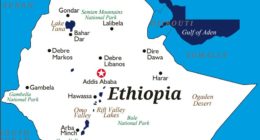Addis Mercato (“New Market”, popularly just Mercato, from the Italian for “market”) is a large open-air marketplace in the Addis Ketema district of Addis Ababa, Ethiopia, and the name refers to the neighborhood in which it is located.
Addis Mercato (“New Market”, popularly just Mercato, from the Italian for “market”) is a large open-air marketplace in the Addis Ketema district of Addis Ababa, Ethiopia, and the name refers to the neighborhood in which it is located.
Largest Open Air Market
Mercato is the largest open air market in Africa, covering several square miles and employing an estimated 13,000 people in 7,100 business entities. The primary merchandise passing through the Merkato is locally grown agricultural products — most notably coffee.
What should be noted, however, is that this isn’t one of those nicely photogenic markets with goods laid out on the ground or in little stalls. Most vendors now have permanent tin shacks to house their wares, so in many eyes this changes the market from a scene of exotica to just a slum.
Everything
The mass of stalls, produce and people may seem impenetrable, but on closer inspection the market reveals a careful organisation with sections for each product. You can spend your Birr on pungent spices, silver jewellery or anything else that takes your fancy. There’s even a ‘recycling market’, where sandals (made out of old tyres), coffee pots (from old Italian olive tins) and other interesting paraphernalia can be found.
Prior to the current Mercato, there was an open market place in Addis Ababa near St. George Church at the site where the City Hall stands now, but it ended with the Italian occupation of the 1930s. The occupiers moved the market further west to the area around the premises of Fitawrari Habte Giyorgis Dinagde, which they named Merkato Indigeno. Thus, the present Addis Merkato was founded by the segregationist policies of the Italian occupational government.
Pickpockets
There are many pickpockets and con artists operating in central Addis Ababa but this is not a problem anywhere else in the country.
Italians
Meanwhile, the Italians restricted the historic St. George Merkato to Europeans, renaming it Piazza, which featured European style shops that displayed commodities through glass windows. The mostly Arab tradesmen who had shops there eventually relocated a half mile to the west. Over time, local shopkeepers displaced the Arab merchants and, since the 1960s, the Addis Merkato has had a mostly local flavor. The Mercato Dijino did not have any plan and gradually grew in width and breadth taking different categorical stocks called “terras”.





